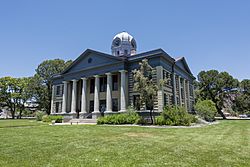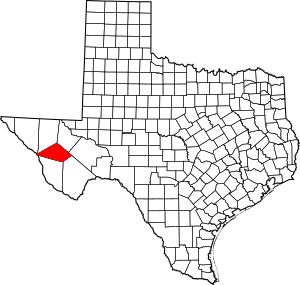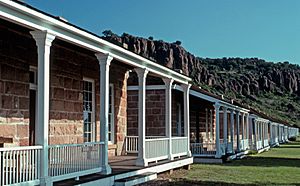Jeff Davis County, Texas facts for kids
Quick facts for kids
Jeff Davis County
|
|
|---|---|
|
County
|
|

Jeff Davis County Courthouse in Fort Davis
|
|

Location within the U.S. state of Texas
|
|
 Texas's location within the U.S. |
|
| Country | |
| State | |
| Founded | 1887 |
| Named for | Jefferson Davis |
| Seat | Fort Davis |
| Largest town | Fort Davis |
| Area | |
| • Total | 2,265 sq mi (5,870 km2) |
| • Land | 2,265 sq mi (5,870 km2) |
| • Water | 0.08 sq mi (0.2 km2) 0% |
| Population
(2020)
|
|
| • Total | 1,996 |
| • Density | 0.8812/sq mi (0.34025/km2) |
| Time zone | UTC−6 (Central) |
| • Summer (DST) | UTC−5 (CDT) |
| Congressional district | 23rd |
Jeff Davis County is a county in the U.S. state of Texas. As of the 2020 census, its population was 1,996. Its county seat is Fort Davis. The county is named for Jefferson Davis, who served as the 23rd United States Secretary of War in the 1850s, and as Confederate president.
Jeff Davis County is recognizable for its unique shape; it is a pentagon that has no north–south nor east–west boundaries, save for a six-mile line serving as its southern boundary. It is the only county in the United States that touches a foreign country (Mexico) at a single point. Jeff Davis is one of the nine counties that compose the Trans-Pecos region of West Texas.
The county contains the 270,000-acre (1,100 km2) Texas Davis Mountains American Viticultural Area. About 50 acres (0.2 km2) are "under vine". The McDonald Observatory, owned by the University of Texas at Austin, is located near Fort Davis.
Contents
History
Native Americans
Prehistoric peoples camped at Phantom Lake Spring, in present-day northeastern Jeff Davis County, and may have used the springs for irrigation. Indian pictographs in the Painted Comanche Camp of Limpia Canyon were discovered by the Whiting and Smith Expedition of 1849.
As white migrants moved into the area, tensions with Native Americans increased. The groups competed for resources, and armed conflicts were conducted for more than two decades, especially after the Civil War. In August 1861, Mescalero Apache under Chief Nicolas attacked Fort Davis, driving off livestock and killing three people. In the ensuing chase by the cavalry, Nicolas ambushed the soldiers, killing them all.
In September 1868 at Horsehead Hills, a group of volunteer Mexican and buffalo soldiers from Fort Davis attacked and destroyed a Mescalero village to recover captives and stolen livestock. In January 1870, a group of soldiers attacked a Mescalero Apache village near Delaware Creek in the Guadalupe Mountains. In July 1880, soldiers at Tinaja de las Palmas attacked a group of Mescaleros led by Chief Victorio. In August 1880, buffalo soldiers ambushed Victorio at Rattlesnake Springs. Victorio retreated to Mexico, where he was killed in October of that year by Mexican soldiers. The last Indian depredation in the area was at Barry Scobee Mountain in 1881.
Early days

In March 1849, Lieutenants William H. C. Whiting and William F. Smith were sent out by Maj. Gen. William J. Worth of the Texas 8th Military Department to look for a route from San Antonio to El Paso del Norte. A second party, led by Dr. John S. Ford and financed by a group of Austin merchants, pioneered a trail that ran north of the Davis Mountains before turning southward toward El Paso. In June 1849 Lt. Col. Joseph E. Johnston, attached to Bvt. Maj. Jefferson Van Horne's battalion, was sent for additional surveying.
At El Paso, Horne established Fort Bliss. Texas Ranger Big Foot Wallace escorted the San Antonio-El Paso Mail coach through the mountains. Fort Davis was established in 1854. The land was leased from surveyor John James at $300 a year. The federal government surrendered the fort to the Confederacy in 1861. The CSA abandoned it in 1862 after their defeat at Glorieta Pass, New Mexico. The facility was reoccupied by U.S. troops on July 1, 1867, as a base for actions against Native American forces.
County establishment and growth
The Texas Legislature established Jeff Davis County on March 15, 1887. Fort Davis was named as the county seat. Cattle ranchers began operating in the county in the 1880s. The towns of Valentine and Chispa became supply centers for the ranchers and were later designated as railroad stops as railway construction entered the area.
Fort Davis has always been the county's largest town. By 1970, Madera Springs was known as the smallest town in Texas. Davis Mountains State Park opened to the public in the 1930s, improved during the Great Depression.
Fort Davis National Historic Site was established in 1961. The Chihuahuan Desert Research Institute arboretum was established in 1974.
Geography
According to the U.S. Census Bureau, the county has a total area of 2,265 square miles (5,870 km2), virtually all of which is land. The county is home to the Davis Mountains, the highest mountain range located entirely within Texas.
Protected areas

The county has parks and preserves maintained by federal and state park services, in addition to the Chihuahuan Desert Research Institute and the Nature Conservancy of Texas. In addition to the properties listed below, the Nature Conservancy has been instrumental in the creation of conservation easements protecting an additional 69,600 acres (28,200 ha) of private property surrounding its preserve.
| Park or preserve | Maintaining authority | Area | Year established |
|---|---|---|---|
| Chihuahuan Desert Nature Center and Botanical Gardens | Chihuahuan Desert Research Institute | 507 acres (205 ha) | 1978 |
| Davis Mountains State Park | Texas Parks and Wildlife Department | 2,709 acres (1,096 ha) | 1933 |
| Davis Mountains Preserve | The Nature Conservancy of Texas | 33,075 acres (13,385 ha) | 1997 |
| Fort Davis National Historic Site | National Park Service | 523 acres (212 ha) | 1961 |
Major highways
 Interstate 10
Interstate 10 U.S. Highway 90
U.S. Highway 90 State Highway 17
State Highway 17 State Highway 118
State Highway 118 State Highway 166
State Highway 166
Adjacent counties and municipalities
- Reeves County (north)
- Pecos County (north)
- Brewster County (southeast)
- Presidio County (south)
- Guadalupe, Chihuahua, Mexico (west)
- Hudspeth County (northwest)
- Culberson County (north)
Climate
Jeff Davis County predominantly experiences a semiarid steppe climate with 83.0% of the county classified as cold semiarid (Köppen BSk) and 0.4% classified as hot semiarid (Köppen BSh). An additional 16.5% is classified as having a hot arid desert climate (Köppen BWh). Within the county, precipitation increases while daytime and nighttime temperatures generally become milder with increasing elevation. Rainfall is most abundant from May through October. Snowfall is also more abundant at higher elevations despite having higher wintertime average low temperatures.
- Fort Davis
- Coordinates: 30°35′59″N 103°53′13″W / 30.59972°N 103.88694°W
- Elevation: 4,892 feet (1,491 m)
| Climate data for Fort Davis, Texas (January 1, 1902–March 31, 2013) | |||||||||||||
|---|---|---|---|---|---|---|---|---|---|---|---|---|---|
| Month | Jan | Feb | Mar | Apr | May | Jun | Jul | Aug | Sep | Oct | Nov | Dec | Year |
| Mean daily maximum °F (°C) | 60.8 (16.0) |
64.4 (18.0) |
71.3 (21.8) |
78.9 (26.1) |
85.8 (29.9) |
90.3 (32.4) |
88.4 (31.3) |
87.4 (30.8) |
83.2 (28.4) |
76.9 (24.9) |
67.5 (19.7) |
60.6 (15.9) |
76.3 (24.6) |
| Mean daily minimum °F (°C) | 28.8 (−1.8) |
31.8 (−0.1) |
37.3 (2.9) |
45.0 (7.2) |
53.4 (11.9) |
60.3 (15.7) |
62.1 (16.7) |
61.0 (16.1) |
55.3 (12.9) |
45.7 (7.6) |
35.9 (2.2) |
29.7 (−1.3) |
45.5 (7.5) |
| Average precipitation inches (mm) | 0.50 (13) |
0.46 (12) |
0.38 (9.7) |
0.54 (14) |
1.31 (33) |
1.98 (50) |
2.85 (72) |
2.91 (74) |
2.27 (58) |
1.35 (34) |
0.54 (14) |
0.55 (14) |
15.64 (397.7) |
| Source: Western Regional Climate Center, Desert Research Institute | |||||||||||||
- McDonald Observatory
- Coordinates: 30°42′19″N 104°01′24″W / 30.70528°N 104.02333°W
- Elevation: 6,790 feet (2,070 m)
| Climate data for Mount Locke, Texas (January 1, 1935–March 31, 2013) | |||||||||||||
|---|---|---|---|---|---|---|---|---|---|---|---|---|---|
| Month | Jan | Feb | Mar | Apr | May | Jun | Jul | Aug | Sep | Oct | Nov | Dec | Year |
| Mean daily maximum °F (°C) | 53.5 (11.9) |
56.9 (13.8) |
63.7 (17.6) |
71.4 (21.9) |
78.6 (25.9) |
84.5 (29.2) |
82.7 (28.2) |
81.3 (27.4) |
76.6 (24.8) |
70.5 (21.4) |
61.2 (16.2) |
54.4 (12.4) |
69.6 (20.9) |
| Mean daily minimum °F (°C) | 32.0 (0.0) |
33.9 (1.1) |
38.2 (3.4) |
45.2 (7.3) |
52.4 (11.3) |
58.2 (14.6) |
58.9 (14.9) |
58.4 (14.7) |
54.4 (12.4) |
48.0 (8.9) |
38.7 (3.7) |
33.6 (0.9) |
46.0 (7.8) |
| Average precipitation inches (mm) | 0.68 (17) |
0.49 (12) |
0.40 (10) |
0.50 (13) |
1.63 (41) |
2.49 (63) |
3.82 (97) |
3.69 (94) |
2.95 (75) |
1.61 (41) |
0.61 (15) |
0.60 (15) |
19.47 (493) |
| Source: Western Regional Climate Center, Desert Research Institute | |||||||||||||
- Valentine
- Coordinates: 30°35′27″N 104°29′29″W / 30.59083°N 104.49139°W
- Elevation: 4,440 feet (1,353 m)
| Climate data for Valentine, Texas (June 1, 1978–March 31, 2013) | |||||||||||||
|---|---|---|---|---|---|---|---|---|---|---|---|---|---|
| Month | Jan | Feb | Mar | Apr | May | Jun | Jul | Aug | Sep | Oct | Nov | Dec | Year |
| Mean daily maximum °F (°C) | 60.3 (15.7) |
65.0 (18.3) |
72.0 (22.2) |
80.0 (26.7) |
87.7 (30.9) |
93.8 (34.3) |
92.1 (33.4) |
90.3 (32.4) |
86.0 (30.0) |
78.9 (26.1) |
68.3 (20.2) |
60.6 (15.9) |
77.9 (25.5) |
| Mean daily minimum °F (°C) | 27.0 (−2.8) |
30.5 (−0.8) |
36.0 (2.2) |
43.3 (6.3) |
52.2 (11.2) |
60.9 (16.1) |
62.9 (17.2) |
61.6 (16.4) |
56.3 (13.5) |
46.6 (8.1) |
35.1 (1.7) |
27.7 (−2.4) |
45.0 (7.2) |
| Average precipitation inches (mm) | 0.42 (11) |
0.46 (12) |
0.24 (6.1) |
0.42 (11) |
0.77 (20) |
1.99 (51) |
2.46 (62) |
2.22 (56) |
2.11 (54) |
1.33 (34) |
0.50 (13) |
0.53 (13) |
13.45 (343.1) |
| Source: Western Regional Climate Center, Desert Research Institute | |||||||||||||
Demographics
As of 2021, Jeff Davis County, with a median age of 60, is one of six counties in the United States with a median age greater than or equal to 60.
| Historical population | |||
|---|---|---|---|
| Census | Pop. | %± | |
| 1890 | 1,394 | — | |
| 1900 | 1,150 | −17.5% | |
| 1910 | 1,678 | 45.9% | |
| 1920 | 1,445 | −13.9% | |
| 1930 | 1,800 | 24.6% | |
| 1940 | 2,375 | 31.9% | |
| 1950 | 2,090 | −12.0% | |
| 1960 | 1,582 | −24.3% | |
| 1970 | 1,527 | −3.5% | |
| 1980 | 1,647 | 7.9% | |
| 1990 | 1,946 | 18.2% | |
| 2000 | 2,207 | 13.4% | |
| 2010 | 2,342 | 6.1% | |
| 2020 | 1,996 | −14.8% | |
| U.S. Decennial Census 1850–2010 2010–2014 2020 |
|||
| Race / Ethnicity (NH = Non-Hispanic) | Pop 2000 | Pop 2010 | Pop 2020 | % 2000 | % 2010 | % 2020 |
|---|---|---|---|---|---|---|
| White alone (NH) | 1,376 | 1,490 | 1,282 | 62.35% | 63.62% | 64.23% |
| Black or African American alone (NH) | 16 | 10 | 0 | 0.72% | 0.43% | 0.00% |
| Native American or Alaska Native alone (NH) | 6 | 8 | 6 | 0.27% | 0.34% | 0.30% |
| Asian alone (NH) | 2 | 7 | 14 | 0.09% | 0.30% | 0.70% |
| Pacific Islander alone (NH) | 0 | 1 | 0 | 0.00% | 0.04% | 0.00% |
| Other race alone (NH) | 1 | 1 | 15 | 0.05% | 0.04% | 0.75% |
| Mixed race or Multiracial (NH) | 23 | 35 | 66 | 1.04% | 1.49% | 3.31% |
| Hispanic or Latino (any race) | 783 | 790 | 613 | 35.48% | 33.73% | 30.71% |
| Total | 2,207 | 2,342 | 1,996 | 100.00% | 100.00% | 100.00% |
As of the 2010 United States Census, 2,342 people were living in the county; 90.2% were White, 1.0% African American, 0.6% Native American, 0.3% Asian, 5.8% of some other race, and 2.0% of two or more races. About 33.7% were Hispanic or Latino (of any race).
As of the census of 2000, 2,207 people, 896 households, and 632 families were living in the county. The population density was less than 1/km2 (2.6/sq mi). The 1,420 housing units averaged less than 1/km2 (2.6/sq mi). The racial makeup of the county was 90.53% White, 0.91% African American, 0.32% Native American, 0.09% Asian, 5.17% from other races, and 2.99% from two or more races. About 35.48% of the population were Hispanic or Latino of any race.
Of the 896 households, 27.30% had children under the age of 18 living with them, 60.80% were married couples living together, 6.90% had a female householder with no husband present, and 29.40% were not families. About 26.30% of all households were made up of individuals, and 10.30% had someone living alone who was 65 older. The average household size was 2.39, and the average family size was 2.88.
In the county, the age distribution was 24.40% under 18, 5.30% from 18 to 24, 24.10% from 25 to 44, 30.00% from 45 to 64, and 16.30% who were 65 or older. The median age was 42 years. For every 100 females, there were 104.50 males. For every 100 females age 18 and over, there were 104.40 males.
The median income for a household in the county was $32,212, and for a family was $39,083. Males had a median income of $27,011 versus $21,384 for females. The per capita income for the county was $18,846. About 14.10% of families and 15.00% of the population were below the poverty line, including 17.10% of those under age 18 and 19.60% of those age 65 or over.
Education
Western Jeff Davis County is served by the Valentine Independent School District, while central and eastern Jeff Davis County are served by the Fort Davis Independent School District.
All of Jeff Davis County is zoned to Odessa College.
Communities
- Valentine
- Fort Davis (county seat)
See also
 In Spanish: Condado de Jeff Davis (Texas) para niños
In Spanish: Condado de Jeff Davis (Texas) para niños


